How Environmental Factors Affect Forest Fire Occurrence in Yunnan Forest Region
Abstract
:1. Introduction
2. Materials and Methods
2.1. Study Area
2.2. Environmental Factors
2.3. Research Method
3. Results
3.1. Spatiotemporal Distribution and Causes of Fire Points
3.2. The Annual and Monthly Dynamic Trends of Environmental Factors
3.3. Spatial Heterogeneity of Environmental Factors
4. Discussion
5. Conclusions
Author Contributions
Funding
Institutional Review Board Statement
Informed Consent Statement
Data Availability Statement
Conflicts of Interest
References
- Krawchuk, M.A.; Moritz, M.A. Constraints on global fire activity vary across a resource gradient. Ecology 2011, 92, 121–132. [Google Scholar] [CrossRef] [PubMed]
- Dantas, V.; Batalha, M.A.; Pausas, J.G. Fire drives functional thresholds on the savanna–forest transition. Ecology 2013, 94, 2454–2463. [Google Scholar] [CrossRef]
- Baker, A.G.; Catterall, C. Managing fire-dependent vegetation in Byron Shire, Australia: Are we restoring the keystone ecological process of fire? Ecol. Manag. Restor. 2016, 17, 47–55. [Google Scholar] [CrossRef]
- Chuvieco, E.; Giglio, L.; Justice, C. Global characterization of fire activity: Toward defining fire regimes from Earth observation data. Glob. Chang. Biol. 2010, 14, 1488–1502. [Google Scholar] [CrossRef]
- Bowman, D.M.; Balch, J.K.; Artaxo, P.; Bond, W.J.; Carlson, J.M.; Cochrane, M.A.; Antonio, C.M.; Defries, R.S.; Doyle, J.C.; Harrison, S.P.; et al. Fire in the Earth system. Science 2009, 324, 481–484. [Google Scholar] [CrossRef] [PubMed]
- Aldersley, A.; Murray, S.J.; Cornell, S.E. Global and regional analysis of climate and human drivers of wildfire. Sci. Total Environ. 2011, 409, 3472–3481. [Google Scholar] [CrossRef] [PubMed]
- Hantson, S.; Pueyo, S.; Chuvieco, E. Global fire size distribution is driven by human impact and climate. Glob. Ecol. Biogeogr. 2015, 24, 77–86. [Google Scholar] [CrossRef]
- Rother, M.T.; Grissino-Mayer, H.D. Climatic influences on fire regimes in ponderosa pine forests of the Zuni Mountains, NM, USA. For. Ecol. Manag. 2014, 32, 69–77. [Google Scholar] [CrossRef]
- Chen, H.; Hu, Y.; Chang, Y.; Bu, R.; Li, Y.; Liu, M. Changes of forest fire regime and landscape pattern under different harvesting modes in a boreal forest of Northeast China. J. Arid Land 2015, 7, 841–851. [Google Scholar] [CrossRef]
- Whitman, E.; Batllori, E.; Parisien, M.A.; Miller, C.; Coop, J.D.; Krawchuk, M.A.; Chong, G.W.; Haire, S.L. The climate space of fire regimes in north-western North America. J. Biogeogr. 2015, 42, 1736–1749. [Google Scholar] [CrossRef]
- Liu, Q.; Shan, Y.; Shu, L.; Sun, P.; Du, S. Spatial and temporal distribution of forest fire frequency and forest area burnt in Jilin Province, Northeast China. J. For. Res. 2018, 29, 1233–1239. [Google Scholar] [CrossRef]
- Parks, S.A.; Holsinger, L.M.; Panunto, M.H.; Jolly, W.M.; Dobrowski, S.Z.; Dillon, G.K. High-severity fire: Evaluating its key drivers and mapping its probability across western US forests. Environ. Res. Lett. 2018, 13, 044037. [Google Scholar] [CrossRef]
- Alencar, A.; Asner, G.P.; Knapp, D.; Zarin, D. Temporal variability of forest fires in eastern Amazonia. Ecol. Appl. 2011, 21, 2397–2412. [Google Scholar] [CrossRef] [PubMed]
- Nolte, C.; Agrawal, A. Linking management effectiveness indicators to observed effects of protected areas on fire occurrence in the Amazon rainforest. Conserv. Biol. 2013, 27, 155–165. [Google Scholar] [CrossRef]
- Smit, I.P.; Smit, C.F.; Govender, N.; Linde MV, D.; MacFadyen, S. Rainfall, geology and landscape position generate large-scale spatiotemporal fire pattern heterogeneity in an African savanna. Ecography 2013, 36, 447–459. [Google Scholar] [CrossRef]
- Alencar, A.A.; Brando, P.M.; Asner, G.P.; Putz, F.E. Landscape fragmentation, severe drought, and the new Amazon forest fire regime. Ecol. Appl. 2015, 25, 1493–1505. [Google Scholar] [CrossRef] [PubMed]
- Attorre, F.; Govender, N.; Hausmann, A.; Farcomeni, A.; Guillet, A.; Scepi, E.; Smit, P.J.; Vitale, M. Assessing the effect of management Chang.s and environmental features on the spatio-temporal pattern of fire in an African Savanna: Fire spatio-temporal pattern. J. Nat. Conserv. 2015, 28, 1–10. [Google Scholar] [CrossRef]
- Pausas, J.G.; Fernández-Muñoz, S. Fire regime Changs in the Western Mediterranean Basin: From fuel-limited to drought-driven fire regime. Clim. Chang. 2012, 110, 215–226. [Google Scholar] [CrossRef]
- Pausas, J.G.; Keeley, J.E. Abrupt climate-independent fire regime Chang.s. Ecosystems 2014, 17, 1109–1120. [Google Scholar] [CrossRef]
- Zhang, Y.; Lim, S.; Sharples, J.J. Modelling spatial patterns of wildfire occurrence in South-Eastern Australia. Geomat. Nat. Hazards Risk 2016, 7, 1800–1815. [Google Scholar] [CrossRef] [Green Version]
- Tian, X.; Zhao, F.; Shu, L.; Wang, M. Distribution characteristics and the influence factors of forest fires in China. For. Ecol. Manag. 2013, 310, 460–467. [Google Scholar] [CrossRef]
- Chen, A.; Tang, R.; Mao, J.; Yue, C.; Li, X.; Gao, M.; Shi, X.Y.; Jin, M.Z.; Ricciuto, D.; Rabin, S.; et al. Spatiotemporal dynamics of ecosystem fires and biomass burning-induced carbon emissions in China over the past two decades. Geogr. Sustain. 2020, 1, 47–58. [Google Scholar] [CrossRef]
- Yi, K.; Bao, Y.; Zhang, J. Spatial distribution and temporal variability of open fire in China. Int. J. Wildland Fire 2017, 26, 122–135. [Google Scholar] [CrossRef]
- Ying, L.; Han, J.; Du, Y.; Shen, Z. Forest fire characteristics in China: Spatial patterns and determinants with thresholds. For. Ecol. Manag. 2018, 424, 345–354. [Google Scholar] [CrossRef]
- Tang, C.Q.; He, L.Y.; Su, W.H.; Zhang, G.F.; Wang, H.C.; Peng, M.C.; Wu, Z.L.; Wang, C.Y. Regeneration, recovery and succession of a Pinus yunnanensis community five years after a mega-fire in central Yunnan, China. For. Ecol. Manag. 2013, 294, 188–196. [Google Scholar] [CrossRef]
- Tsai, C.L.; Behera, S.K.; Waseda, T. Indo-China monsoon indices. Sci. Rep. 2015, 5, 8107. [Google Scholar] [CrossRef]
- Egger, J.; Zuyu, T. A note on the dynamics of the quasi-stationary Kunming front. Meteorol. Atmos. Phys. 1992, 48, 225–229. [Google Scholar] [CrossRef]
- Ying, L.; Shen, Z.; Yang, M. Wildfire detection probability of MODIS fire products under the constraint of environmental factors: A study based on confirmed ground wildfire records. Remote Sens. 2019, 11, 3031. [Google Scholar] [CrossRef]
- Xiao, X.; Haberle, S.G.; Li, Y.; Liu, E.; Shen, J.; Zhang, E.; Yin, J.; Wang, S. Evidence of Holocene climatic Chang. and human impact in northwestern Yunnan Province: High-resolution pollen and charcoal records from Chenghai Lake, southwestern China. Holocene 2018, 28, 127–139. [Google Scholar] [CrossRef]
- Wang, S.; Chen, M.; Cao, R.; Cao, Q.; Zuo, Q.; Wang, P.; Yang, B.; Zhao, S. Contribution of plant litter and soil variables to organic carbon pools following tropical forest development after slash-and-burn agriculture. Land Degrad. Dev. 2019, 31, 1071–1077. [Google Scholar] [CrossRef]
- Ye, J.; Wu, M.; Deng, Z.; Xu, S.; Zhou, R.; Clarke, K.C. Modeling the spatial patterns of human wildfire ignition in Yunnan province, China. Appl. Geogr. 2017, 89, 150–162. [Google Scholar] [CrossRef]
- Xiao, X.; Haberle, S.G.; Shen, J.; Xue, B.; Burrows, M.; Wang, S. Postglacial fire history and interactions with vegetation and climate in southwestern Yunnan Province of China. Clim. Past 2017, 13, 613–627. [Google Scholar] [CrossRef]
- Myers, N.; Mittermeier, R.A.; Mittermeier, C.G.; Da Fonseca, G.A.; Kent, J. Biodiversity hotspots for conservation priorities. Nature 2000, 403, 853–858. [Google Scholar] [CrossRef] [PubMed]
- Yang, Y.; Tian, K.; Hao, J.; Pei, S.; Yang, Y. Biodiversity and biodiversity conservation in Yunnan, China. Biodivers. Conserv. 2004, 13, 813–826. [Google Scholar] [CrossRef]
- Hong, X.U.; Xiao, Y.; Yong, Z.H.U. Study on the forest fire danger forecast in Yunnan Province based on GIS and RS. J. Fujian For. Sci. Technol. 2007, 34, 85–88. [Google Scholar]
- Van Zyl, J.J. The Shuttle Radar Topography Mission (SRTM): A breakthrough in remote sensing of topography. Acta Astronaut. 2001, 48, 559–565. [Google Scholar] [CrossRef]
- Catry, F.X.; Rego, F.C.; Bação, F.L.; Moreira, F. Modeling and mapping wildfire ignition risk in Portugal. Int. J. Wildland Fire 2009, 18, 921–931. [Google Scholar] [CrossRef]
- Gray, M. Landscape-Scale Models and Maps of Fire Risk and Connectivity in the Lower Sonoran Desert. Ph.D. Thesis, Northern Arizona University, Flagstaff, AZ, USA, 2013. [Google Scholar]
- Guo, F.; Wang, G.; Su, Z.; Liang, H.; Wang, W.; Lin, F.; Liu, A. What drives forest fire in Fujian, China? Evidence from logistic regression and Random Forests. Int. J. Wildland Fire 2016, 25, 505–519. [Google Scholar] [CrossRef]
- Zeng, A.C.; Cai, Q.J.; Su, Z.W.; Guo, X.B.; Jin, Q.F.; Guo, F.T. Seasonal variation and driving factors of forest fire in Zhejiang Province, China, based on MODIS satellite hot spots. Ying Yong Sheng Tai Xue Bao J. Appl. Ecol. 2020, 31, 399–406. [Google Scholar]
- Guo, F.; Su, F.; Wang, G.; Sun, L.; Tigabu, M.; Yang, X.; Hu, H. Understanding fire drivers and relative impacts in different Chinese forest ecosystems. Sci. Total Environ. 2017, 605, 411–425. [Google Scholar] [CrossRef]
- Mitri, G.; Saba, S.; Nader, M.; McWethy, D. Developing Lebanon’s fire danger forecast. Int. J. Disaster Risk Reduct. 2017, 24, 332–339. [Google Scholar] [CrossRef]
- Elia, M.; Giannico, V.; Lafortezza, R.; Sanesi, G. Modeling fire ignition patterns in Mediterranean urban interfaces. Stoch. Environ. Res. Risk Assess. 2019, 33, 169–181. [Google Scholar] [CrossRef]
- Gao, C.; Lin, H.L.; Hu, H.Q.; Song, H. A review of models of forest fire occurrence prediction in China. Ying Yong Sheng Tai Xue Bao J. Appl. Ecol. 2020, 31, 3227–3240. [Google Scholar]
- Tien Bui, D.; Le, K.T.T.; Nguyen, V.C.; Le, H.D.; Revhaug, I. Tropical forest fire susceptibility mapping at the Cat Ba National Park Area, Hai Phong City, Vietnam, using GIS-based kernel logistic regression. Remote Sens. 2016, 8, 347. [Google Scholar] [CrossRef]
- Guo, F.; Su, Z.; Tigabu, M.; Yang, X.; Lin, F.; Liang, H.; Wang, G. Spatial modelling of fire drivers in urban-forest ecosystems in China. Forests 2017, 8, 180. [Google Scholar] [CrossRef]
- Hanley, J.A.; McNeil, B.J. The meaning and use of the area under a receiver operating characteristic (ROC) curve. Radiology 1982, 143, 29–36. [Google Scholar] [CrossRef]
- Vilar del Hoyo, L.; Martín Isabel, M.P.; Martínez Vega, F.J. Logistic regression models for human-caused wildfire risk estimation: Analysing the effect of the spatial accuracy in fire occurrence data. Eur. J. For. Res. 2011, 130, 983–996. [Google Scholar] [CrossRef]
- Taylor, A.E. Statistical Enhancement of Support Vector Machines; Oregon State University: Corvallis, OR, USA, 2009. [Google Scholar]
- Janitza, S.; Strobl, C.; Boulesteix, A.L. An AUC-based permutation variable importance measure for random forests. BMC Bioinform. 2013, 14, 119. [Google Scholar] [CrossRef]
- Pausas, J.G.; Bradstock, R.A. Fire persistence traits of plants along a productivity and disturbance gradient in mediterranean shrublands of south-east Australia. Glob. Ecol. Biogeogr. 2007, 16, 330–340. [Google Scholar] [CrossRef]
- Abatzoglou, J.T.; Williams, A.P. Impact of anthropogenic climate Chang. on wildfire across western US forests. Proc. Natl. Acad. Sci. USA 2016, 113, 11770–11775. [Google Scholar] [CrossRef]
- Hanes, C.C.; Wang, X.; Jain, P.; Parisien, M.A.; Little, J.M.; Flannigan, M.D. Fire-regime Chang.s in Canada over the last half century. Can. J. For. Res. 2019, 49, 256–269. [Google Scholar] [CrossRef]
- Bajocco, S.; Koutsias, N.; Ricotta, C. Linking fire ignitions hotspots and fuel phenology: The importance of being seasonal. Ecol. Indic. 2017, 82, 433–440. [Google Scholar] [CrossRef]
- Alcasena, F.J.; Salis, M.; Ager, A.A.; Arca, B.; Molina, D.; Spano, D. Assessing landscape scale wildfire exposure for highly valued resources in a Mediterranean area. Environ. Manag. 2015, 55, 1200–1216. [Google Scholar] [CrossRef] [PubMed] [Green Version]
- Han, J.; Shen, Z.; Li, Y.; Luo, C.; Xu, Q.; Yang, K.; Zhang, Z. Beta diversity patterns of post-fire forests in central Yunnan Plateau, southwest China: Disturbances intensify the priority effect in the community assembly. Front. Plant Sci. 2018, 9, 1000. [Google Scholar] [CrossRef]
- Huang, X.; Li, M.; Li, J.; Song, Y. A high-resolution emission inventory of crop burning in fields in China based on MODIS Thermal Anomalies/Fire products. Atmos. Environ. 2012, 60, 9–15. [Google Scholar] [CrossRef]
- van Wees, D.; van Der Werf, G.R.; Randerson, J.T.; Andela, N.; Chen, Y.; Morton, D.C. The role of fire in global forest loss dynamics. Glob. Chang. Biol. 2021, 27, 2377. [Google Scholar] [CrossRef]
- Lee, S.S.; Seo, Y.W.; Ha, K.J.; Jhun, J.G. Impact of the western North Pacific subtropical high on the East Asian monsoon precipitation and the Indian Ocean precipitation in the boreal summertime. Asia-Pac. J. Atmos. Sci. 2013, 49, 171–182. [Google Scholar] [CrossRef]
- Lee, S.S.; Wang, B. Regional boreal summer intraseasonal oscillation over Indian Ocean and Western Pacific: Comparison and predictability study. Clim. Dyn. 2016, 46, 2213–2229. [Google Scholar] [CrossRef]
- Zhao, Y.; Hu, Y.M.; Zhang, X.C.; Wang, L.; Chen, F.; Zhao, Z. Spatial pattern of farming distance in rural area using ESDA. Sci Geogr. Sin. 2016, 36, 760–765. [Google Scholar]
- Yan, Z.; Zhang, Y.; Zhou, Z.; Han, N. The spatio-temporal variability of droughts using the standardized precipitation index in Yunnan, China. Nat. Hazards 2017, 88, 1023–1042. [Google Scholar] [CrossRef]
- Li, S.Y.; Ma, C.L.; Luo, W.B.; Li, S.H.; Wang, X.F.; Yuan, J.J.; Yang, L. Combustibility ordering and sorting of 35 woody plant species in Kunming area. Chin. J. Ecol. 2008, 27, 867–873. [Google Scholar]
- LI, S.; Chang, N.; Guan, X.; Wang, Q.H.; Shu, L.F. Combustion characteristics of live branches of 15 common woody plant species in Kunming, Yunnan Province. Chin. J. Ecol. 2012, 31, 276–281. [Google Scholar]
- Cattau, M.E.; Harrison, M.E.; Shinyo, I.; Tungau, S.; Uriarte, M.; DeFries, R. Sources of anthropogenic fire ignitions on the peat-swamp landscape in Kalimantan, Indonesia. Glob. Environ. Chang. 2016, 39, 205–219. [Google Scholar] [CrossRef]
- Buntaine, M.T.; Mullen, R.B.; Lassoie, J.P. Human use and conservation planning in Alpine areas of Northwestern Yunnan, China. Environ. Dev. Sustain. 2007, 9, 305–324. [Google Scholar] [CrossRef]
- Liu, Z.; Yang, J.; Chang, Y.; Weisberg, P.J.; He, H.S. Spatial patterns and drivers of fire occurrence and its future trend under climate Chang. in a boreal forest of Northeast China. Glob. Chang. Biol. 2012, 18, 2041–2056. [Google Scholar] [CrossRef]
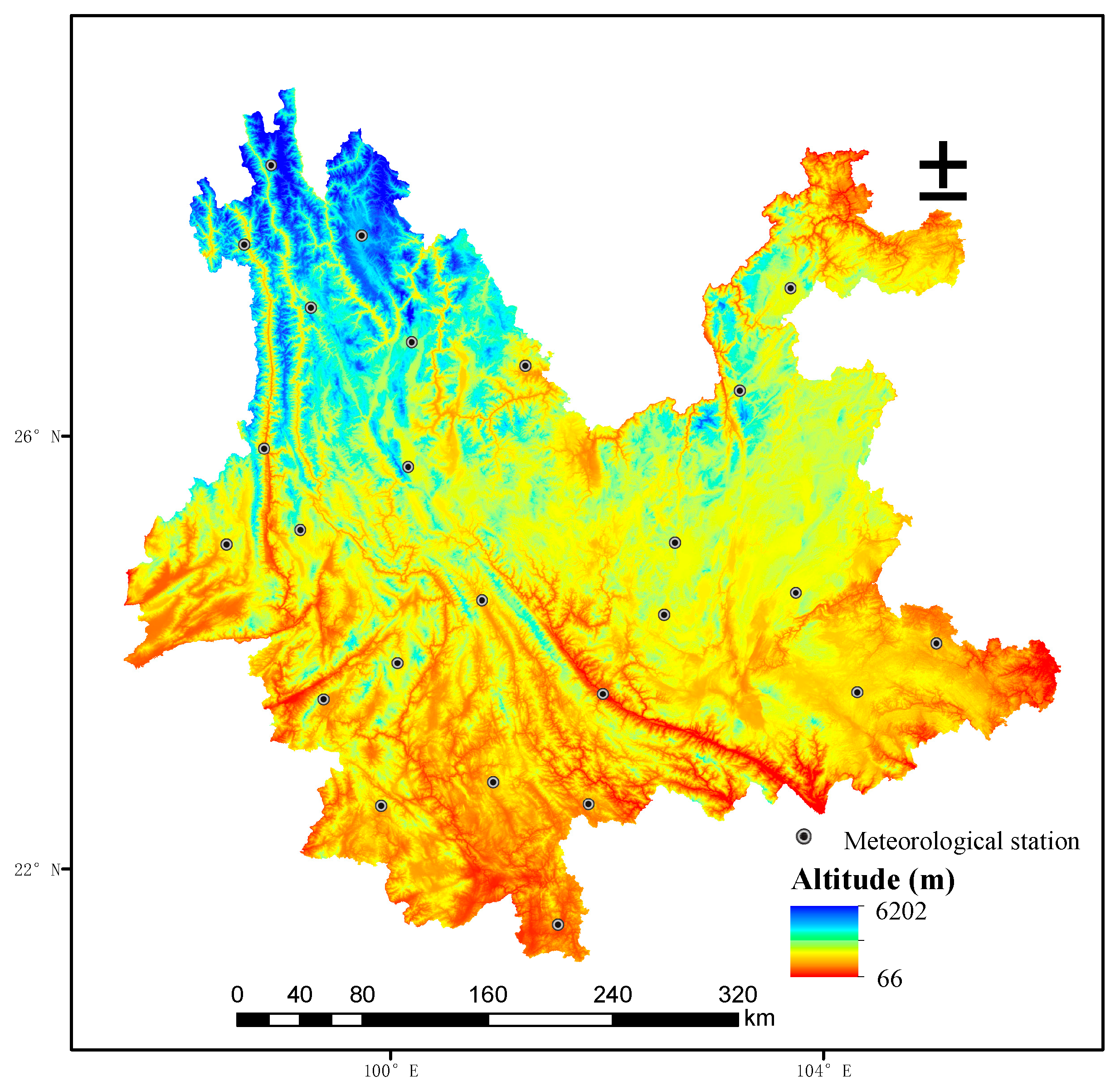
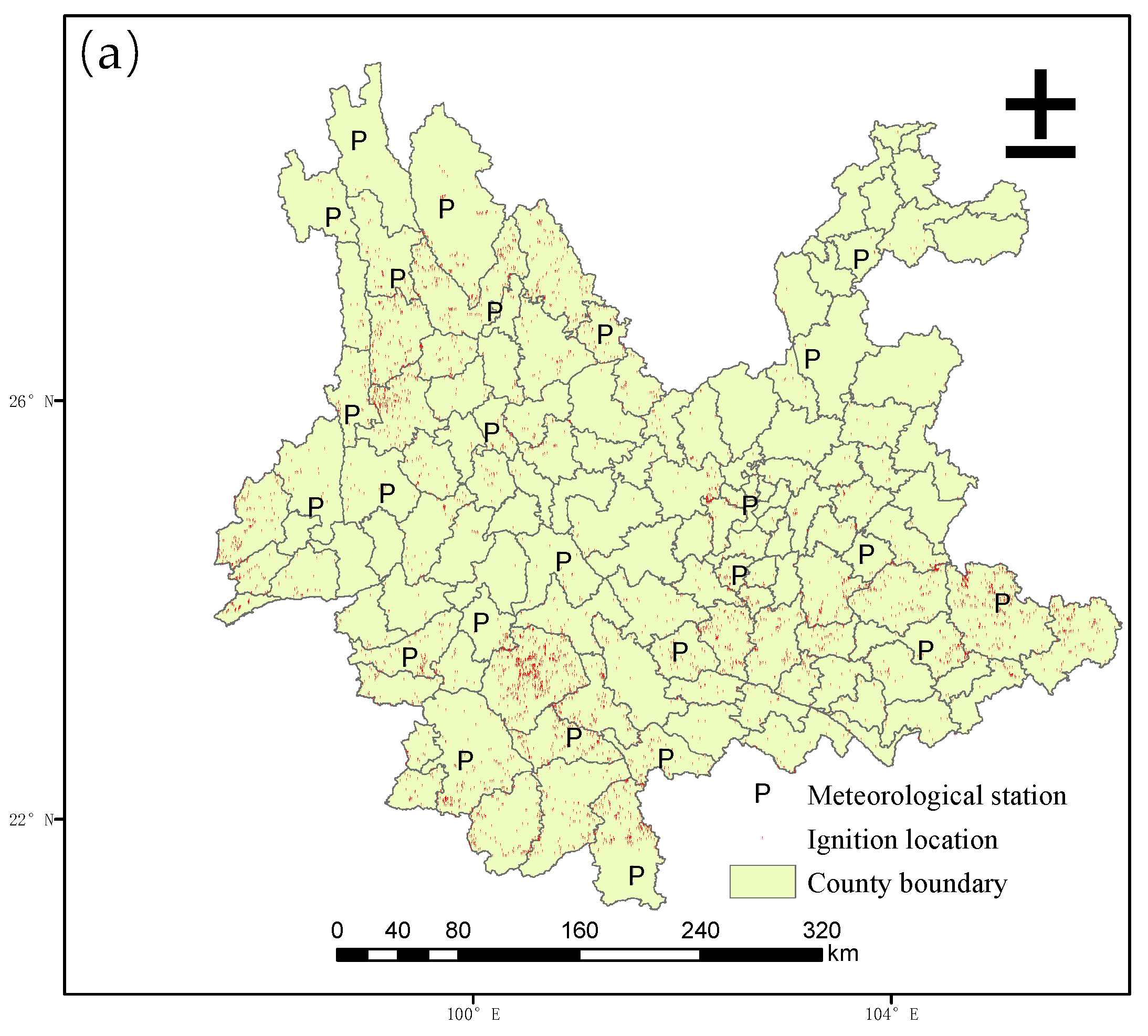
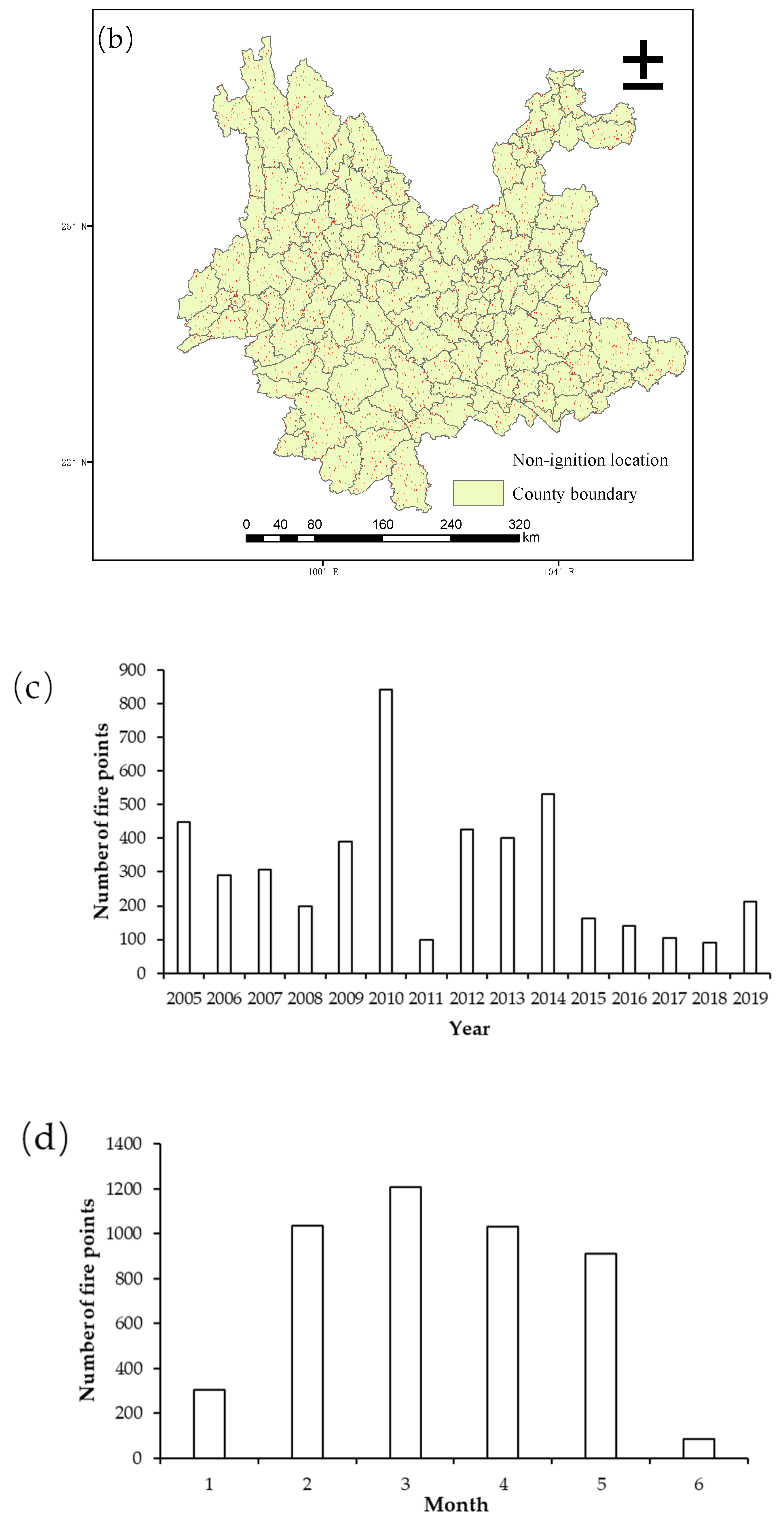


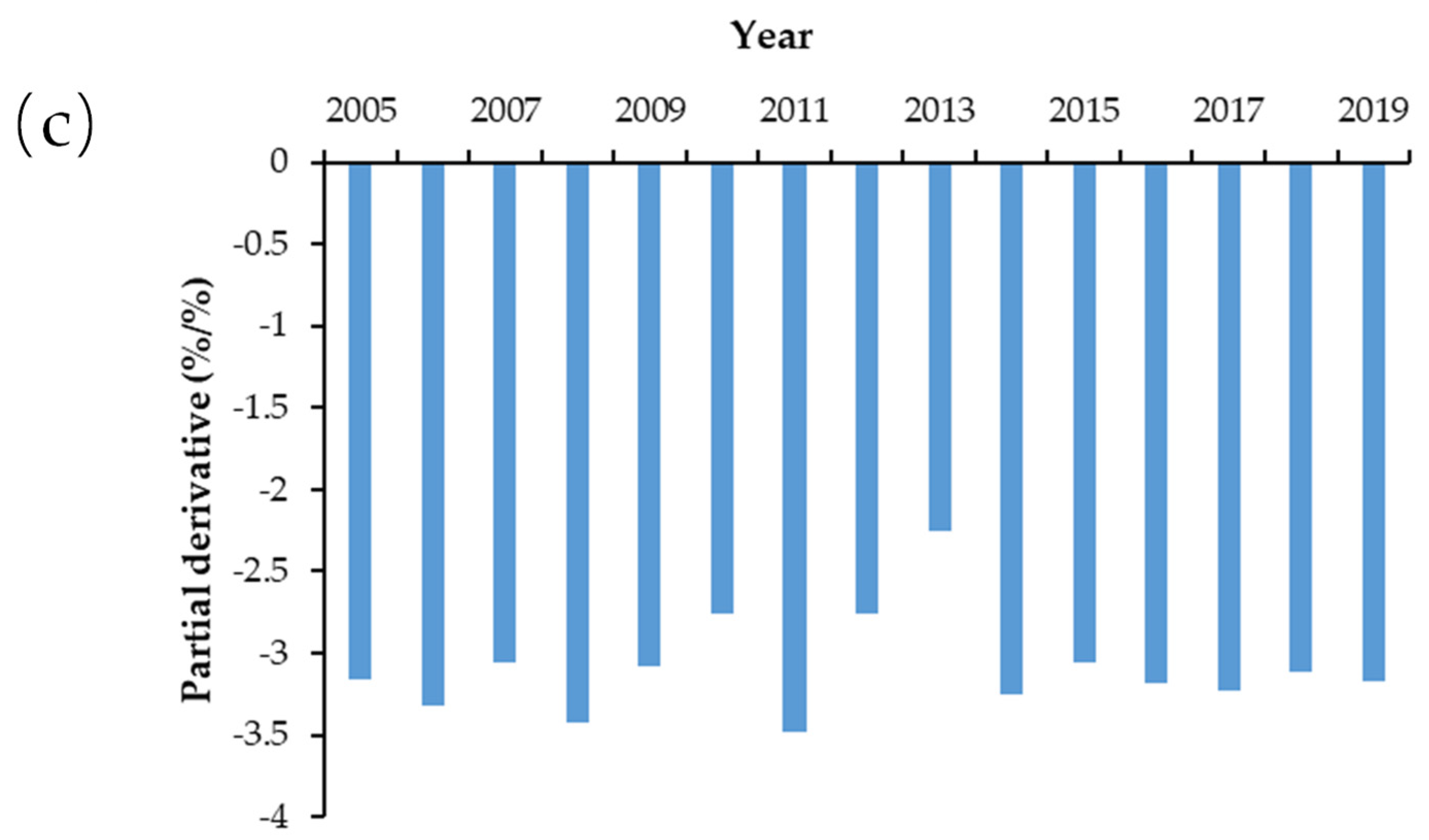

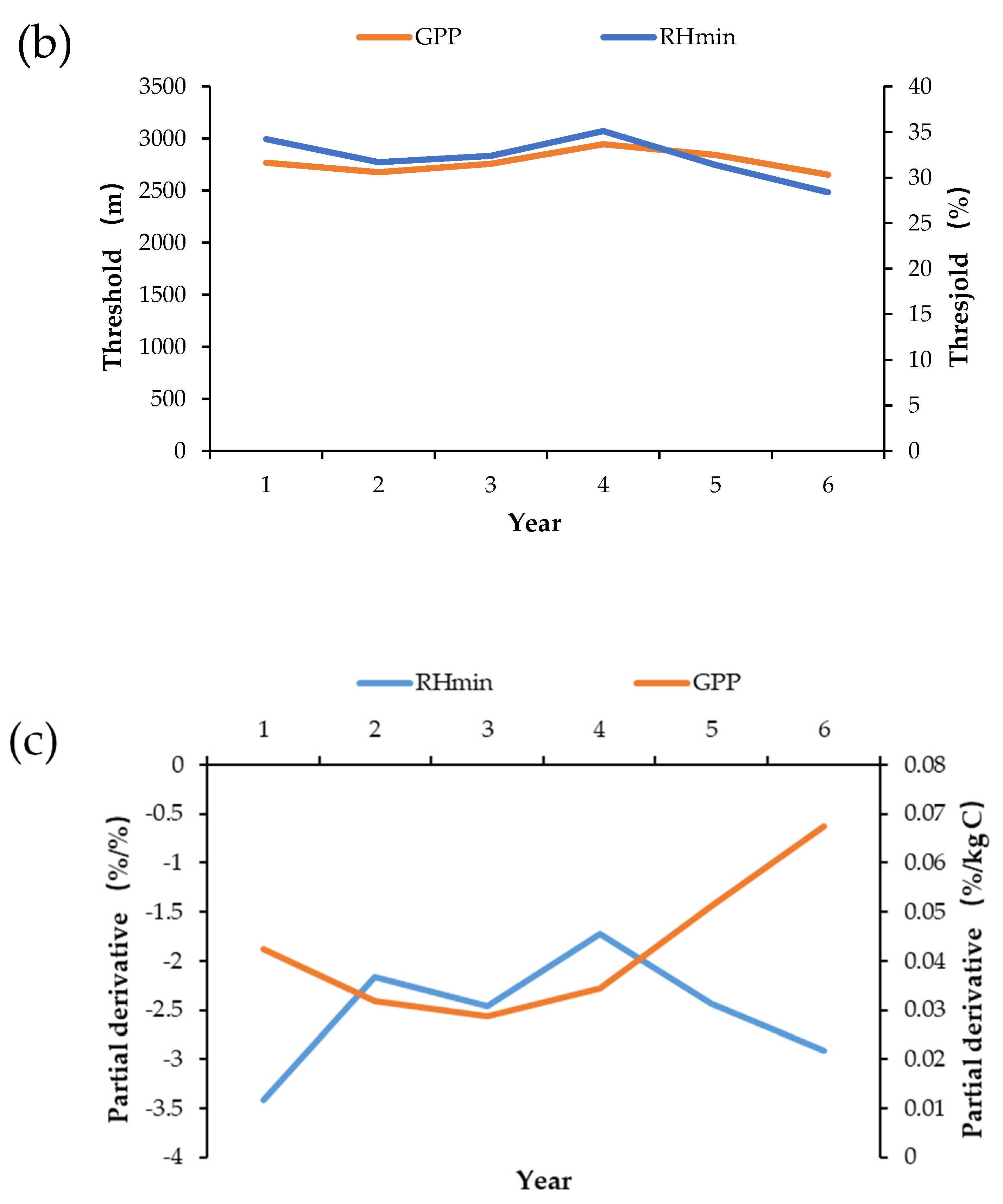

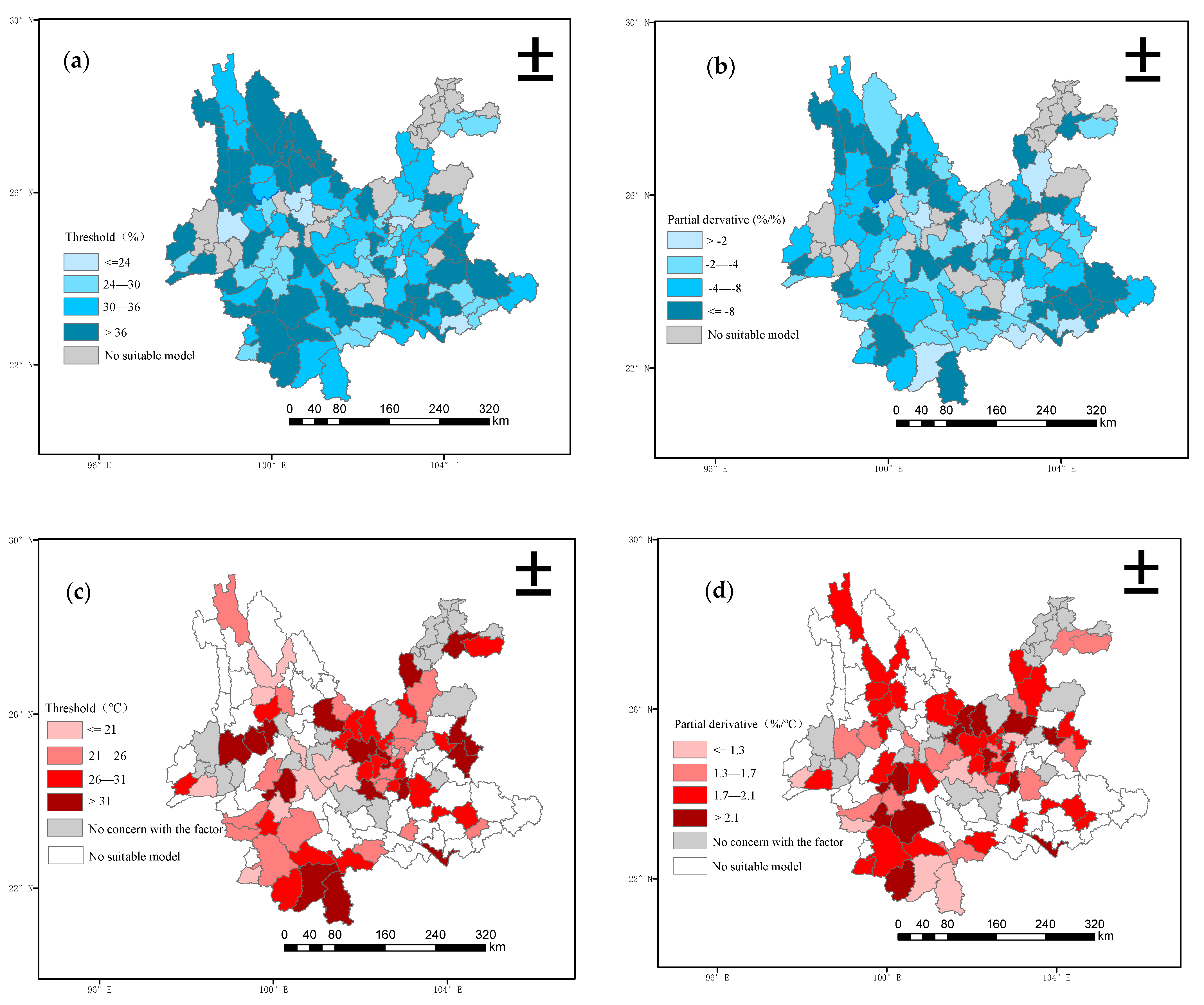

| Variable Type | Variable Factor | Data Sources | Unit |
|---|---|---|---|
| Precipitation | mm | ||
| Maximum temperature | °C | ||
| Meteorological | Minimum relative humidity | China National Meteorological Information Center | Relative humidity (RH%) |
| Maximum wind speed | m/s | ||
| Sunshine duration | h | ||
| Altitude | m | ||
| Terrain | Slope | Digital elevation database | ° |
| NS-Aspect | ° | ||
| EW-Aspect | ° | ||
| Combustible substance | GPP | NASA | kg C |
| Human activity | Distance from residence | 1:250,000 National Basic Geographic Information Database | m |
| Distance from road | m |
| Variables | Regression Coefficients | Threshold (±Standard Deviation) of 50% IgnitionProbability | Partial Derivative |
|---|---|---|---|
| Precipitation | −1.52 × 10−1 | 8.16 (±6.46) | −3.79 |
| Minimum relative humidity | −1.22 × 10−1 | 28.07 (±11.85) | −3.05 |
| Sunshine duration | 4.3 × 10−2 | 7.32 (±3.43) | 1.07 |
| Maximum temperature | 6.8 × 10−2 | 21.23 (±11.15) | 1.70 |
| Maximum wind speed | 1.34 × 10−1 | 5.32 (±2.19) | 3.35 |
| Distance from residence | 2.26 × 10−4 | 1.33 × 103 (±1.07 × 103) | 5.00 × 10−3 |
| Distance from road | 9.57 × 10−5 | 2.39 × 103 (±1.79 × 103) | 2.50 × 10−3 |
| Slope | 9.63 × 10−3 | 46.32 (±24.52) | 2.50 × 10−1 |
| Altitude | −6.49 × 10−5 | 2.45 × 103 (1.12 × 103) | 1.50 × 10−3 |
| GPP | 1.28 × 10−3 | 2.59 × 103 (1.22 × 103) | 3.25 × 10−2 |
| Constant | −2.23 | - | - |
Publisher’s Note: MDPI stays neutral with regard to jurisdictional claims in published maps and institutional affiliations. |
© 2022 by the authors. Licensee MDPI, Basel, Switzerland. This article is an open access article distributed under the terms and conditions of the Creative Commons Attribution (CC BY) license (https://creativecommons.org/licenses/by/4.0/).
Share and Cite
Zhu, Z.; Deng, X.; Zhao, F.; Li, S.; Wang, L. How Environmental Factors Affect Forest Fire Occurrence in Yunnan Forest Region. Forests 2022, 13, 1392. https://doi.org/10.3390/f13091392
Zhu Z, Deng X, Zhao F, Li S, Wang L. How Environmental Factors Affect Forest Fire Occurrence in Yunnan Forest Region. Forests. 2022; 13(9):1392. https://doi.org/10.3390/f13091392
Chicago/Turabian StyleZhu, Zheng, Xiaofan Deng, Fan Zhao, Shiyou Li, and Leiguang Wang. 2022. "How Environmental Factors Affect Forest Fire Occurrence in Yunnan Forest Region" Forests 13, no. 9: 1392. https://doi.org/10.3390/f13091392
APA StyleZhu, Z., Deng, X., Zhao, F., Li, S., & Wang, L. (2022). How Environmental Factors Affect Forest Fire Occurrence in Yunnan Forest Region. Forests, 13(9), 1392. https://doi.org/10.3390/f13091392






